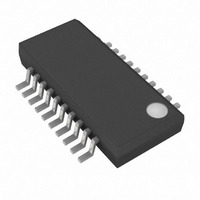MAX1865TEEP+T Maxim Integrated Products, MAX1865TEEP+T Datasheet - Page 14

MAX1865TEEP+T
Manufacturer Part Number
MAX1865TEEP+T
Description
IC PWR SUPPLY CONTROLLER 20QSOP
Manufacturer
Maxim Integrated Products
Datasheet
1.MAX1864TEEE.pdf
(25 pages)
Specifications of MAX1865TEEP+T
Applications
Power Supply Controller
Voltage - Input
4.5 ~ 28 V
Current - Supply
1.4mA
Operating Temperature
-40°C ~ 85°C
Mounting Type
Surface Mount
Package / Case
20-QSOP
Lead Free Status / RoHS Status
Lead free / RoHS Compliant
Voltage - Supply
-
Lead Free Status / Rohs Status
Lead free / RoHS Compliant
xDSL/Cable Modem Triple/Quintuple Output
Power Supplies
If VL drops below 3.5V, the MAX1864/MAX1865
assume that the supply voltage is too low to make valid
decisions, so the undervoltage lockout (UVLO) circuitry
inhibits switching, forces POK low, and forces the DL
and DH gate drivers low. After VL rises above 3.5V,
internal digital soft-start is initiated (see Soft-Start).
Externally, the MAX1864/MAX1865 starts switching
when VL rises above the 3.5V undervoltage lockout
threshold. However, the controller is not enabled unless
all four of the following conditions are met: 1) VL
exceeds the 3.5V undervoltage lockout threshold, 2)
the internal reference exceeds 90% of its nominal value
(V
up, and 4) the thermal limit is not exceeded. Once the
MAX1864/MAX1865 assert the internal enable signal,
the step-down controller starts switching and enables
soft-start.
Upon power-up, the MAX1864/MAX1865 begin a start-
up sequence. First, the reference powers up. Then, the
main DC-DC step-down converter and positive linear
regulators power up with soft-start enabled. Once the
regulators reach 90% of their nominal value and soft-
start is complete, the active-high ready signal (POK)
goes high (see Power-Good Output).
Soft-start gradually ramps up to the reference voltage
in order to control the rate of rise of the output voltages
and reduce input surge currents during startup. The
soft-start period is 1024 clock cycles (1024/f
the internal soft-start DAC ramps up the voltage in 64
steps. The output reaches regulation when soft-start is
completed, regardless of output capacitance and load.
The power-good output (POK) is an open-drain output.
The MOSFET turns on and pulls POK low when any out-
put is less than 90% of its nominal regulation voltage or
during soft-start. Once all of the outputs exceed 90% of
their nominal regulation voltages and soft-start is com-
pleted, POK goes high impedance. To obtain a logic
voltage output, connect a pullup resistor from POK to
VL. A 100kΩ resistor works well for most applications. If
unused, leave POK grounded or unconnected.
14
REF
______________________________________________________________________________________
> 1.114V), 3) the internal bias circuitry powers
Undervoltage Lockout
Power-Good Output
Startup Sequence
Soft-Start
OSC
), and
Thermal-overload protection limits total power dissipa-
tion in the MAX1864/MAX1865. When the junction tem-
perature exceeds T
down the device, forcing DL and DH low, allowing the
IC to cool. The thermal sensor turns the part on again
after the junction temperature cools by 10°C, resulting
in a pulsed output during continuous thermal-overload
conditions. If the VL output is short circuited, thermal-
overload protection is disabled.
During a thermal event, the main step-down converter
and the linear regulators are turned off, POK goes low,
and soft-start is reset.
The step-down controller’s feedback input features
Dual Mode operation. Connect the output to OUT and
connect FB to GND for the preset 3.3V output voltage.
Alternatively, the MAX1864/MAX1865 output voltage
may be adjusted by connecting a voltage-divider from
the output to FB to GND (Figure 4). Select R2 in the
5kΩ to 50kΩ range. Calculate R1 with the following
equation:
where V
1.236V to approximately 0.8 x V
> 5.5V, then connect OUT to GND (MAX1864) or to one
of the positive linear regulators (MAX1865) with an out-
put voltage between 2V and 5V.
Three key inductor parameters must be specified:
inductance value (L), peak current (I
resistance (R
constant LIR, which is the ratio of inductor peak-to-
peak AC current to DC load current. A higher LIR value
allows smaller inductance but results in higher losses
and higher output ripple. A good compromise between
size and losses is a 30% ripple-current to load-current
ratio (LIR = 0.3). The switching frequency, input volt-
age, output voltage, selected LIR determine the induc-
tor value as follows:
SET
L
= 1.236V, and V
DC
R
=
1
). The following equation includes a
V
=
Thermal-Overload Protection
IN SW LOAD MAX
DC-DC Step-Down Converter
J
R
V
ƒ
2
OUT IN
= +160°C, a thermal sensor shuts
⎡
⎢
⎢
⎣
⎛
⎜
⎝
I
V
(
V
V
OUT
SET
Design Procedure
Output Voltage Selection
-
V
(
⎞
⎟
⎠
OUT
OUT
IN
-
1
⎤
⎥
⎥
⎦
(up to 20V). If V
)
LIR
)
may range from
PEAK
Inductor Value
), and DC
OUT











